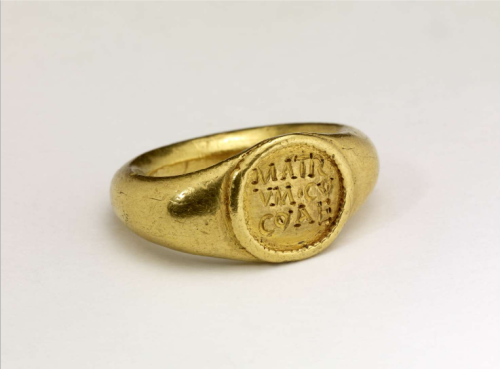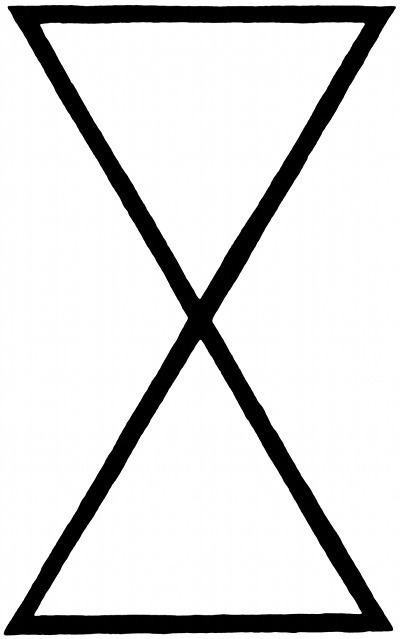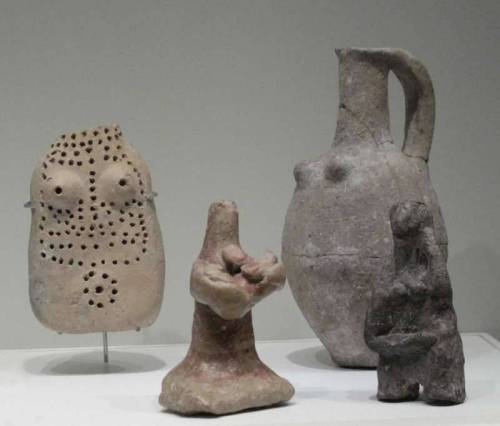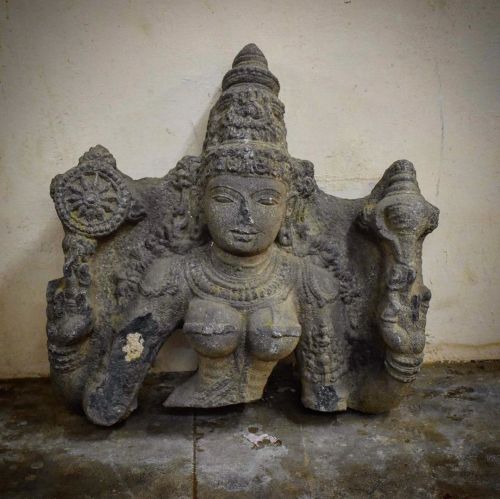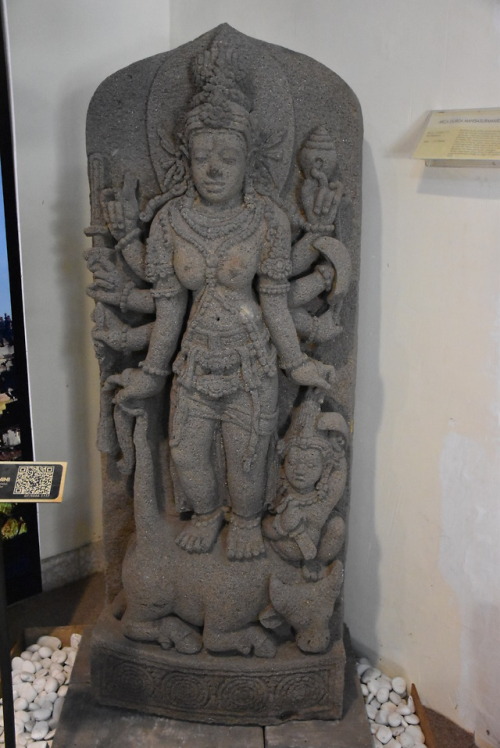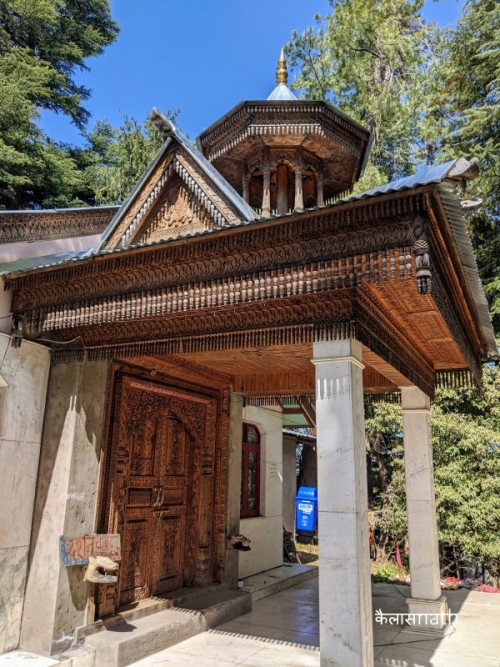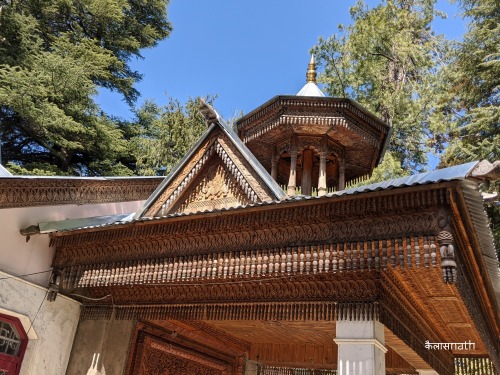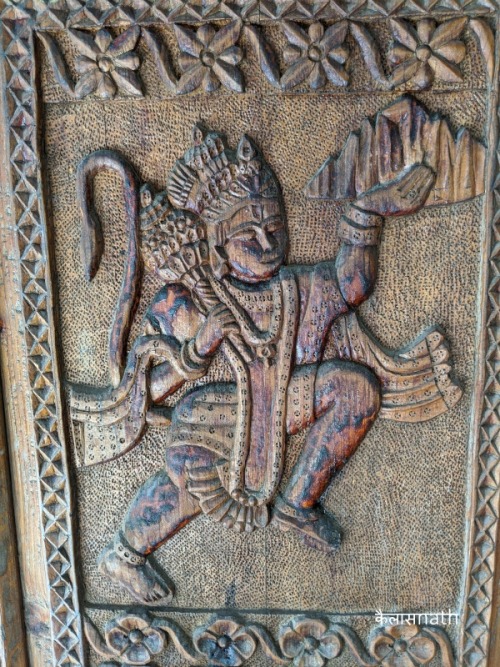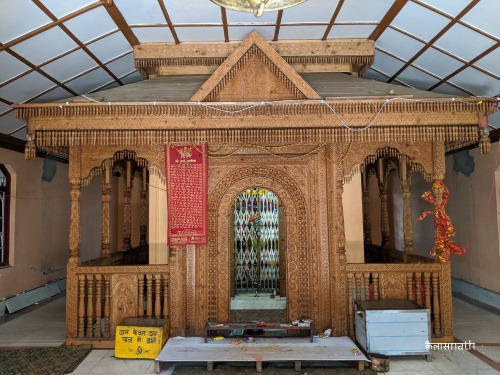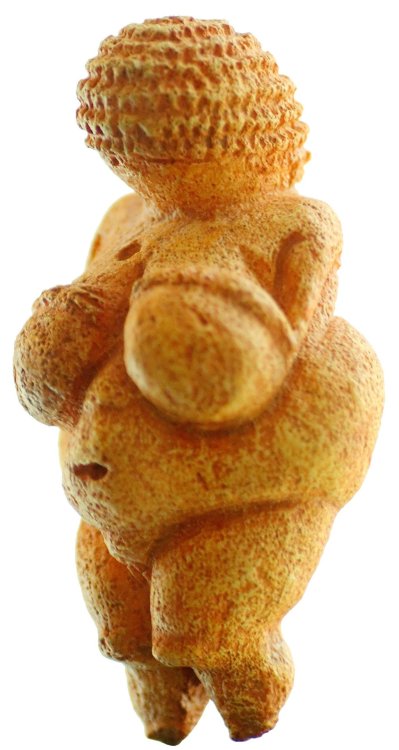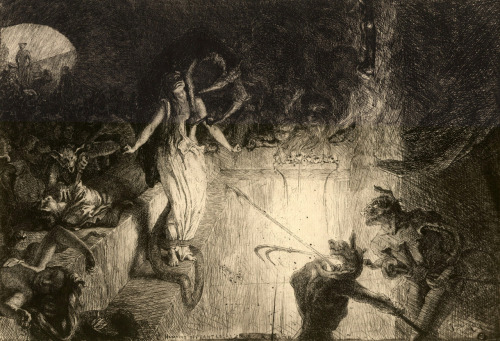#mother goddess
Silver skillet, with a highly decorated handle and some gilding. The bowl is deep, with slightly incurving walls forming a constriction in the line of the profile below the small everted rim.
The general theme of the decoration is the traditional one of acanthus scrolls and flowers, with some elements picked out by gilding. The central area of the handle carries the inscription MATR FAB / DVBIT in bold, neat lettering. The outlines of the letters are filled with a roughened surface to provide a key for the heavy gilding, perhaps more accurately termed ‘gold inlay’, which survives on the V, B and T of 'DVBIT’.
The skillet, part of the Backworth Hoard, bears a votive inscription dedicated to the Mother-Goddesses by a Fab(ius) Dubit(atus?).
The history of this hoard is obscure. We know that it was found around 1811, but not where it was found. The hoard was said to have included about 280 coins, but all but one of these, and probably other objects, were dispersed before The British Museum was able to acquire what was left of the treasure in 1850. The surviving coin is a denarius of Antoninus Pius (reigned AD 138-161) issued in AD 139.
The treasure was probably a votive deposit at a shrine of the Mother-goddesses near the eastern end of Hadrian’s Wall.
1st - 2nd century AD
© The Trustees of the British Museum
Post link
Gold finger-ring with slight flattening of the shoulders. The hoop is slightly bevelled in cross-section. The almost circular gem-setting is empty, and encircled at the rim with applied beaded wire, which is heavily worn. The floor of the setting has been scraped flat, but not polished, and bears a three-line inscription: MATR/VM CO/COAE. Although the exact translation is uncertain, this is certainly a votive gift to the Mother Goddesses. The inscription is probably secondary, engraved after a gemstone setting had been lost.
Found in Backworth (England), part of the Backworth Hoard.
The history of this hoard is obscure. We know that it was found around 1811, but not where it was found. The hoard was said to have included about 280 coins, but all but one of these, and probably other objects, were dispersed before The British Museum was able to acquire what was left of the treasure in 1850. The surviving coin is a denarius of Antoninus Pius (reigned AD 138-161) issued in AD 139.
The treasure was probably a votive deposit at a shrine of the Mother-goddesses near the eastern end of Hadrian’s Wall.
1st - 2nd century AD
© The Trustees of the British Museum
Post link
“…BECAUSE THE EARTH IS SENDING UP DEITIES THAT ARE TELLING PEOPLE TO DESTROY THAT WHICH IS CREATING THE ATROCITY OF SUFFERING AND RAPE OF LIFE THAT IS CHRISTIAN-BASED SOCIETY.”
Post link
Figure 5 (p19).
“In allowing her boundaries to be penetrated from within by an emerging Other, the Goddess demonstrated her true creativity. She became the universal Mother. This crucial moment of birth was synonymous with creation, according to the ancient concept. This was the moment when the Goddess (not the emerging God) said, ‘Let there be light,’ because the eyes of her newborn first perceived the light of existence, as he himself might become the light of fire or the sun. In the classical world, the Goddess had names like Juno Lucina or Diana Lucifera, the Bringer of Light. From her the biblical Yahweh copied his Fiat lux.
“The god’s birth was celebrated each year at midwinter. The nocturnal festival was known as the Night of the Mother to pre-Christian Britons, which may explain why Christmas Eve (the time of the actual birth) carried even more significance in Old England than Christmas Day. In Alexandria, the god’s birth was hailed by joyful shouts: ‘The Virgin (Kore) has given birth! The light grows!’ The naked image of the divine birth-giving Virgin was decorated with gold stars and carried seven times around the temple.
“Just as, in pagan belief, creation was a birth, so every birth was a new creation. Each year the Aeon or year-god was reborn from the eternally virgin, eternally maternal Goddess. Thus, at the mystic point of creation itself, the graphic symbol of the Mother became three broken lines, while that of her son-spouse was three solid lines.
“Male and female triangles, one separated, came together again in a very ancient figure that later rounded off to the mathematical symbol of infinity in so-called Arabic numerals, which were actually Hindu in origin. The two tangential circles or teardrop shapes of this sign meant the same as two tangential triangles: the two sexes in contact (Fig. 5). The female triangle above now took on the aspect of a nourishing breast, while the male received her nourishment.
“This was also taken as a sexual sign, in unconscious but nevertheless real recognition of the connection between adult sexuality and bond between mother and infant. According to Tantric symbolism, the female triangle was placed above the male, who then assumed all forms of relationship with her: offspring, twin, spouse, and eventually sacrificial victim, as he became the eternally dying-and-reborn god, similar to Osiris, Attis, Dionysus, Adonis, Orpheus, Yama, and so on. Therefore Tantric yogis and their shaktis (priestesses) favored female-superior sexual positions, which Vedic and Confucian patriarchs condemned because of their association with the Old Religion that they wanted to erase. Though this style of lovemaking was instituted by Shiva as Universal God and the original ‘daughters of the sages’ (shaktis), patriarchal Brahman priests insisted that it was a perversion” (p17-18).
Glyph from Barbara Walker‘s The I Ching of the Goddess
Post link
Me: *mindfully stirring my mug of coffee with its 2 shots of espresso, 2 full spoons of sugar, and a dollop of creamer* “I dedicate my wakefulness and self care to my goddesses.”
Artemis: “That’s a lot of caffeine, sugar, and creamer even for us, my daughter.”
Devi Vaishnavi (one of the Saptamatrikas) or Vishnu Durgai
11th Century, Chola Era
The broken nature of this exquisite sculpture makes it difficult to be certain which form of the Goddess the Vigraha represents. This is one of the several beautiful but broken sculptures lying in the under-resourced and ramshackle Government Museum at the site of the magnificent Chola Monument of Gangaikonda. (at Gangaikondapuram, Tamil Nadu, India)
Post link
Devī Durgā Mahiśāsuramardinī
A magnificent stone sculpture of the Goddess Durgā slaying the buffalo-demon Mahiśāsura. The Devī is depicted in her eight-armed (aṣṭabhuja) form – she holds the demon Mahiśā by his hair as he emerges from the buffalo form as she readies to strike the fatal blow.
Durgā Mahiśāsuramardinī was popularly worshipped across the Hindu kingdoms of Java throughout the Hindu – Buddhist period.
This well-preserved icon from the Prambanan complex probably belongs to the 9th or 10th Century CE.
Post link
Talāī Bhadrakālī Mañdir
In the town of Talāī,MāśobrānearŚimlā amidst the pine and deodar trees is this shrine to Devī Bhadrakālī,the benevolent protective form of Devī Mahākālī.
The present temple is of somewhat recent provenance but the pahāḍī architecture and styling made of ornately carved wood is of highly traditional design. The sloping roof is designed for snow to slide off; the ornate carvings depict geometrical patterns as well as images of Hindu deities.
Post link
The mother goddess, right? Wrong wrong WRONG! The so-called Willendorf Venus dates somewhere between 24,000 and 22,000 BCE, although it’s not as if Josef Szombathy could have called that one when he found this figurine in a cave near Willendorf, Austria in 1908. Carbon-14 dating was in its infancy in 1908, as you can imagine, since it wasn’t invented until 1949. We have learned now that this figurine is incredibly old. In fact, it’s so old that a similar figurine found relatively nearby made of fired ceramic is the oldest piece of ceramic ever found.
So why would anybody think this was the mother goddess? Well, that is a really good question. First of all, who was the mother goddess? Short answer, she was a goddess whose first monuments rose up from the mountaintops of central Anatolia in about the eighth century BCE and whose last altars were dedicated in the fourth century CE. There were other goddesses known as mother, but this mother goddess was so enduring and widespread (Anatolia to France) that she gets the title.
So around twenty thousand years passed in between the carving of this stone figurine and the earliest monuments to the mother goddess. What happens in twenty thousand years? Well, I don’t know, a ton of stuff. Written history has only been a thing for like, five thousand, so it’s pretty hard for me to imagine twenty thousand years basically!!
Around the turn of the century everyone was soooo into the grand narrative. Everyone was so obsessed with writing a continuous story about all of human civilization and progress. It was the hot thing. But here is the problem! People didn’t know a ton of facts about all this old stuff back then. Surprise! It’s way too old to possibly be continuous.
So about this Venus of WIllendorf. Maybe it’s not the mother but surely it must be some kind of mother goddess, right? Look at her curves! Come on! Fertility goddess, right? Fertility amulet? Right?
Sorry guys. With almost no context for this figurine, we are going to have to start from scratch. Stone figurine of a female, around twenty-six thousand years old, found in a cave in Austria. Well, I don’t know, people got the creative impulse. Look at her pretty braided hair.
Post link
Bishamon or Bishamonten from “Seven Gods of Fortune” in Shintoism is the typical “strong woman” trope character in a Shonen anime called Noragami: she is angry, she is beautiful and conveniently buxom for fans to drool over her. Termed by Yato as “ugly broad” Bishamon is fierce and coarse. However, she is not only that: she has a caring and nurturing side which almost caused her demise once and put her in danger over and over again. So this is my take on Bishamon and why she is the Eastern archetype of “Warrior Mother Goddess” instead of her Shinto persona.

First of all, let’s look what Bishamon actually is in the Classic Shinto religion. In Japan, Bishamonten (毘沙門天), or just Bishamon (毘沙門) is thought of as an armor-clad god of war or warriors and a punisher of evildoers. Bishamon is portrayed holding a spear in one hand and a small pagoda in the other hand, the latter symbolizing the divine treasure house, whose contents he both guards and gives away. His (because Bishamon is a male in Shintoism) legend derives from the Hindu Demigod “Vaisravana” or “Son of Vishrava”, who is known as Kubera the God of wealth. Both Vaisravana and Bishamon are associated with material fortunes and Bishamon is really a fierce version of Vaisravana, a well-fed, content and rather gluttonous demigod.
But how a god like Bishamon gets transferred in Noragami to a woman? It could be a design choice by Adachitoka to create a contrasting female character who could meet Yato in a more Godly plane. But I can see some clear Hindu influence in Bishamon’s design. She is inhumanly beautiful, fierce, perfect body and with rapunzel length hair. Her design is very similar to the Warrior Goddess Durga. In the “Meditation of Durga” she is described as
“the one with great length-ed dreadlocks in her head…whose face is beautiful like the full moon, whose complexion is as fair as flax seed flower…whose beautiful teeth sit on her full lips, whose full breasts hold the elixir of immortality*– (Meditation of Durga, verse 1-3)
The physical description of Durga has uncanny similarity with Bishamon. the Goddess is also called “nabayouvana sampannang, sarbabharana bhushitang” (who is young and clad with fantastic jewels). Bishamon may be young and beautiful but she does not wear any eastern jewels: she is rather clad with her regalias posed as weapons, navigation and clothes; thus it isn’t far off.

It is not only the superficial physical appearance that are similar with Durga and Bishamon; they also share some character similarities. The traditional Bishamonten is not known to have a mount or Divine Familiar, Bishamon in the anime on the other hand does a divine familiar in the form of mount: Kuraha, who takes the shape of Lion and can travel in the air. This is an iconic similarity with Durga, whose divine mount is a lion. In “hymns of Gandhesvari” Durga (or her Gandhesvari form) is described as “Simhasta” (the one who rides a lion). Durga is also known as “Simha vahini” (she whose vehicle is a lion). The Bishamonten is known to carry only one weapon, a spear, but Bishamon in Noragami has or carries multiple weapons because she has multiple regalia. In the “Meditation of Durga” the goddess is known to carry a goad, bow and arrow, executioner’s sword, discus, conch, mace, shield, rosary and the trident. Bishamon too carries multiple weapons: whip, guns, knife long machete etc, just like Goddess Durga herself. One part of Durga’s weapon is “Aveda barma” or the “impenetrable armour” forged by the ironsmith of the Gods, Vishwakarma (the forger of the universe). Bishamon wears a full blown armour by her regalia Aiha when the Ebisu-crisis occured and she had to journey to underworld.
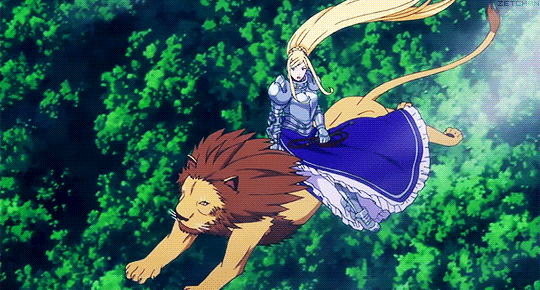
Now, in the parallel of two warrior goddesses who seem to be far from society’s idea of ideal femininity, where does the nurturing part fit? According to the Hindu mythology Durga is only a fragment of the ideal femininity: the rightful rage of “Adi Shakti” (Ancient Energy), the Female mother goddess. (Excuse my jargon) in the “Durga Saptashati” of Rigveda, the Goddess is described as “mother of all creation” (verse no 3) and at the same time she is described as “creator, sustainer and destroyer of the world” (verse no 4) of which she is the Mother. Bishamon has an extensive collection of regalia: she does not discriminate who is weak or who is useful, she takes everyone in as her own according to Noragami Wiki:
“She willingly accepts any wandering and troubled spirit, useful or not, and adds them to her family. “
She and her Shinkis live in Takamagahara which is the universe on its own, so she is the guardian and mother of her Shinkis in a way. Takamagahara is situated in a place which has golden hued galaxy as the backdrop of the sky. The form of Durga which alludes to the primeval Female Goddess is called “Bhuvaneswari” (she, whose body is the universe). The shinkis or regalias derive strength from her divine existence and they exist in a palpable form because of her. It again alludes to “Devi Suktam” (the introduction of the Goddess) where is has been mentioned:
“ I am the Queen of the Universe; I give wealth to those who worship me. I am the all-knowing one and the prime one among the worshippable deities. I enter many bodies as the Soul, taking various forms and with different manifestations, in various ways. … That one who eats food, who sees, breathes, and hears whatever is said, he does all that only through me (my powers). Those who do not understand me, die. “ –(Devi Suktam, verse 4 & 5)
The sense of being center of the universe has brought a tremendous sense of loss and grief to the goddesses in many occassion. In the myths, when Goddess Parvati (the calm version of Durga) loses her child Ganesha, she assumes her rageful spirit again to destroy the universe that has taken her child from her. Bishamon has faced tremendous sense of loss and grief when she lost her “Ma” clan due to the malefic thoughts of the Shinkis–an action which blighted her tremendously. She too assumes a vengeful spree towards Yato, who allegedly slaughtered her “Ma” clan.
In short Bishamon is a great representation of motherly strength in anime field: the term “mother” often evokes a sense of tenderness, security and comfort, but it has been proven in the ancient myth that bringing life into the world and the sense of protectiveness towards life is the most powerful energy of all: it can make an break everything in existence and when the motherly tenderness is challenged it can manifest in one of the most destructive forces in the world. Thus the “ugly broad” “stern powerhouse” persona is only skin deep. The essence of Bishamon is far greater and more empowering.
* In ancient India, full breasts of a woman, which are swollen with milk was granted as a symbol of motherly power, nourishment and comfort. A woman with moderate breast size or small breast size were considered equally beautiful. In fact talking about sexuality in religious and secular discourses by scholars and sages were acceptable. It has no sexual connotation whatsoever. Please don’t perverse it in any sense.
…
wow that’s a lot, now tags (although I have no evidence that they like Noragami)
:@sidd-hit-my-butt-ham@yanderebakugo@kurokonbscenarios@kurokonobasket@kurokonoboisket@art-zites@idinaxye@sp-chernobyl@strawbe3ryshortcake@reservethemoon@rilnen@a-shy-potato@thirsthourdemon@animebxxch@edagawasatoru@akawaiishi-blog@reinyrei@chloe-noir@theswahn@ahobaka-trash@jeilliane@trashtoria @scarlettedwardsposts@quirkydarling@ghostieswaifu@levihan-freaks@hope-im-spirited-away@yves0809@marshiro1101 @bubziles @heartfullofknb@kit-kat57@akichan-th
“A man might befriend a wolf, even break a wolf, but no man could truly tame a wolf.”▼
~ George R.R. Martin
Post link
“Maria Magdalena” as Sophia by Carlo Crivelli (1435-1495) ▼ ~ You shoulda saw Her!(Listen song)
Post link
△“It’s a wonderful story. Did you know that our universe is the result of an error and that it’s partly my fault? Sophia was the female part of Absolute, because Absolute then was more female than male; it was you men who later put a beard on him and started calling him He. I was his good half. (…) I tried to create the world without asking permission—I, the Sophia, who is also called—the Ennoia. But my male part didn’t want to create; maybe he lacked the courage or was impotent. So instead of uniting with him, I decided to make the world by myself. I couldn’t resist; it was through an excess of love. Which is true; I adore this whole mixed-up universe. And that’s why I’m the soul of this world. (…) ~ You mean the Demiurge? ~ That’s him, yes. Or maybe it wasn’t Sophia who made this Demiurge; maybe he was already around and she egged him on: Get moving, silly, make the world, and then we’ll have real fun. The Demiurge must have been a real screwup, because he didn’t know how to make the world properly. In fact, he shouldn’t even have tried it, because matter is bad, and he wasn’t authorized to touch the stuff. Anyway, he made this awful mess, and Sophia was caught inside. Prisoner of the world.”▼
~ Umberto Eco (,Foucault’s Pendulum’, chapter 5 Gevurah/50) Pictures: 1. Anima Mundi = Sophia; 2. art by Marcel Roux; 3. Virgin Mother.
Post link
Isis
La gran diosa madre de la mitología egipcia
———————————————————
The great mother goddess of ancient Egypt
Art by Francisco Javier Cruz Domínguez (Javhier Cruz)
https://www.facebook.com/javhiercruz
Post link
Me: *lies down* “I’m so tired…”
Artemis: *strokes my hair* “Take a nap, darling one.”
Me: *falls asleep* *sleeps* *wakes up feeling better*



